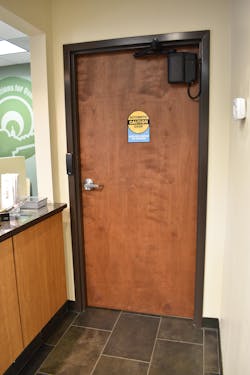Providing Mobile Tech Opportunities for Your Clients
Several themes and trends on the technology side of the security industry today promise long-term changes to the way we approach the business of keeping people and places safe and secure. But for all the promise of the Internet of Things, and all the potential of cloud computing and edge analytics, the technology shift with the most immediate impact is likely to be mobile access for enterprise, commercial and multi-family housing applications.
This shift in expectation from traditional access control to mobile access is occurring as individuals have discovered that their current mobile devices can be used to operate locks within their own homes. Meanwhile, enterprises are adapting to the idea of using more robust mobile credentialing solutions.
Previous mobile credentialing systems in large scale enterprises typically required company-issued and company-controlled devices, which required a high level of training and came at a high price. However, the demand created by the residential sector means that both the cost and requirement for training have been lowered as barriers to entry. Systems can now be integrated affordably, and the requirements and use of mobile credentials are far more intuitive for users.
In short: the landscape for what is considered standard access control has changed and demand for this technology will only continue to grow. For locksmiths, the need to expand core competencies, reset customer expectations of what your shop can do, and working in a consultative process with clients are critical steps during this time.
Increase Training and Knowledge
The best insulator for your business during a shift from traditional lock and key systems to mobile access control is to increase staff training. The end goal should be to fully understand mobile credentialing – how it works, where it is best applied and how to install and service it. If you consider mobile applications and mobile credentials the new lock and key, this is simply an expansion of your current expertise.
One way to expand this is to look at becoming a certified integrator of particular products. ASSA ABLOY, for example, provides a certified integrator program that offers intensive, hands-on training for security systems integrators and network administrators. Speaking with one of our certified integrators, he explained that having hands-on experience with the products you intend to sell or install is the most critical way to learn.
“We deployed these technologies in our own offices. Doing so, you force your team to use it and understand how it works, where it works best and how to talk with customers about it,” said Chad Lingafelt, Managing Partner at Loc Doc Security in Charlotte, N.C. “You really need to have a new product in your hands and use it in a practical sense.”
Doing Business with Mobile Apps
This method of installing at the shop is also helpful to understand robust offerings in the field and to display those offerings to customers. ASSA ABLOY offers a unique solution to mobile credentialing technology through HID Mobile Access®, which leverages Seos® as the underlying credential technology. Seos offers the freedom of using any device of choice – from smart cards to smart phones – for secure access to more applications.
By installing door and opening hardware that uses Seos, security professionals can blend traditional systems with new mobile applications and mobile credentialing. But to show how that works, the system needs to be up and running. For Loc Doc Security, that means installing mobile technologies in locations where customers visiting the sales floor can view the operation first hand.
This takes the branding and image from being a locksmith to being more of a complete security integrator. Most locksmiths are far more than just keysmiths, and demonstrating these competencies is critical.
Beyond just demonstrating the systems, it is also critical to listen to the needs of the client and make sure that new mobile applications will work for them. Locksmiths should ask what the customer is trying to achieve, what level of security is actually necessary, and – if something like mobile credentialing applies – will they be able to maintain and manage the data they are using?
If the answer to that last question is “no,” then the next query is if you are up to the task to manage it for them. And that makes the process cyclical as it goes back to increasing your own staff’s training and knowledge
The reality is that mobile apps and mobile credentialing will improve overall business operations. The benefits to facilities include better workforce management, streamlined security processes, and increased security through the use of audit trails and simple revocation.
For other markets, such as universities or hospitals, the use of a technology like Seos allows for phased upgrades over the course of many years. It allows for temporary access to be granted to individuals such as contractors, vendors and students, regardless of the chosen credential.
Also worth consideration in terms of access control management is the ability to manage access from anywhere, not just the office. A mobile, cloud-based service, such as Yale Accentra™ lock management software for multi-family housing, allows for this in a secure, manageable and cost-effective approach. But, again, it requires competency from the locksmith in order to offer it as a solution.
Because of these improvements to the security process, mobile technology is here for the long haul. So once you’ve taken the steps to add the technology to your offerings, make sure you take practical next steps to offer them to end users.
For locksmiths and integrators, this means starting with a decision on what credential will best suit the needs of the facility, which starts by looking at which services the credential needs to support (physical access, logical access, printing, vending, dining, etc.). By approaching this discussion at the start of a project, you can explain the advantages, dispel any myths, and begin offering future-proof systems that involve mobile technologies.
Peter Boriskin is Vice President of Commercial Product Management, ASSA ABLOY
